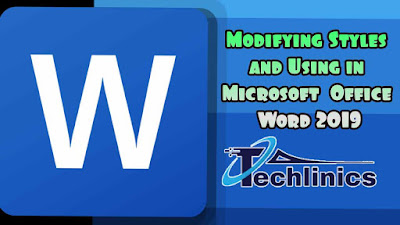HOW MODIFYING STYLES AND USING IN MICROSOFT OFFICE WORD
 |
| Microsoft office Word 2019 |
As you can see here, I have a Word document with a couple of what would probably be headings at the tops of each of these pages here.
Most people, when faced with the idea of reformatting this content, would probably highlight things like the introduction or all of these paragraphs here and then use the Font group up at the top of the screen in order to change the font of these paragraphs or of the headings up at the top, things like that.
I'm going to recommend that instead of using the Font group at the top left-hand side of the Home ribbon, instead, use the Styles group over here on the right-hand side.
Notice here that no matter what text I have selected, it says that this is the normal text for this document.
In fact, when I right-click on Normal and I choose Modify, I see in here that this is deciding that normal means that we use Caliber font, we use 11-point text, we use left alignment, etc.
In fact, if you wanted to see how the spacing between the paragraphs work, you can even go down here to the Format button on the bottom left-hand corner, go over here to Paragraph, and as you can see right in here, the spacing after the paragraph is currently set to eight points.
That's how I can see that little extra gap between each of the paragraphs right here.
When I go up here to Introduction, for example, and I can apply here Heading 1 to Introduction.
I can go to Segment 1 and apply Heading 1, and I can go to Segment 2 and apply Heading 1, and Segment 3 and apply Heading 1, and the conclusion and apply Heading 1. You can see there, of course, each of them looks the same.
- It's got the same font, the same color, etc.
- But a lot of times, people look at this and they say I don't like the way that looks.
- But if you noticed what I just did a second ago; I'm going to right-click on Heading 1 this time, choose Modify, and let's say that instead of Caliber Light, you prefer Times New Roman.
- Let's say that instead of 16-point font, you prefer 18-point font.
- Let's say that you prefer it to be bold-ed and you don't want color in there, you're just going to go straight black with it.
- Then when we click OK, you'll notice that Introduction, Segment 1, Segment 2, Segment 3, and the conclusion all look exactly the same, and I didn't have to go through my (mumbles) to make those modifications because I applied Heading 1 to all those different areas by right-clicking on the heading, going to Modify, and then changing from one thing to another.
- Let's say I go to Lobster, for example, and I hit OK. You can see that all of my headings are now this Lobster font.
- In the same way, let's say you have a co-worker who loves to make all the body text into Times New Roman or Arial or something like that.
- You can always right-click on the Normal font here, go to Modify, and again, on the drop-down menu here, let's say Arial is going to be the font on most of the text in my document.
- When I click OK, you can see that all the text that's in my document that's not a Heading 1 all updates to look like Arial. Now we'll go one step further than this.
- Any time that you modify a style by right-clicking on that style and choosing Modify, in the bottom left-hand corner, you'll notice that the current changes are being applied to this document only.
- If you want your Microsoft Word consistently create documents that look the same, you can go to New documents based on this template here and then click OK.
- Now what happens here is that I have changed Normal away from the Caliber font over to Arial font. When I go to File, New, and I open up a new blank document, you'll notice here that this text is all in Arial font.
- That's because I right-clicked on Normal, went to Modify, and after I set it to Arial, I chose the option that said new documents based on this template should all be Arial.
- In the opposite direction here, if I go back to Caliber as my standard body text and I choose new documents based on this template should all use Caliber instead and click OK, of course this changes from Arial to Caliber.
- But in addition, when I go to File, New, make a new blank document, this is Caliber.
- That's important because now you're guaranteed that every time you open Microsoft Word, every time you create a new document, you're consistently using the same fonts across the board.
- One last reason why using styles can be so helpful; as you can see here with Introduction, Segment 1, Segment 2, Segment 3, and Conclusion, I have multiple different areas in my document that are on different pages.
- What if I needed a table of contents? Most people unfortunately find themselves creating a table of contents by hand by actually typing this out.
- But by creating a series of headings in my document, when I go to the References tab at the top of the screen in Microsoft Word and I choose the Table of Contents drop-down menu, notice in here this thing called Automatic Table 1.
It already says Heading 1, Heading 2, and Heading 3 in it. So when I choose this, it just goes ahead and inserts the introduction, segment 1, segment 2, segment 3, and the conclusion, and it's on pages one, two, three, four, and five.
In fact, when I go to my introduction here and I put in a page frame pushing the introduction onto page number two instead of page number one, I can go to this table of contents here on the left, click the Update Table button at the top of the screen and click OK, and you can see here that the introduction is now on page two instead of page one, and Segment 1 is now on page three, etc.Using styles and modifying those styles by right-clicking on them and choosing Modify allows you to create a systematic structure within your documents, allows you to create automatic tables of contents from that, and also allows you to apply that same formatting to every document you make from here on out in Microsoft Word.
Do you have a preferred style that you add in? Is there something here that you'd like to go ahead and tweak? Go ahead and ask those questions down in the comments below.
If this was valuable to you, make sure you like and share, and have a great day.








